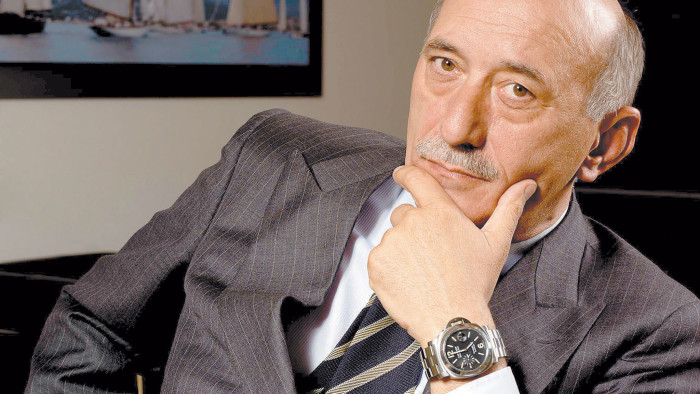Brand development: Founded 1860 – just in time for the 21st century

Roula Khalaf, Editor of the FT, selects her favourite stories in this weekly newsletter.
Many established watch brands are extremely wary in the current market. Which makes Officine Panerai’s optimism about its prospects and its bullish strategies for growth all the more surprising.
The company started life in 1860 as a Florentine workshop and school that provided the Italian navy with specialist diving instruments, but its timepieces only hit international retail markets as recently as 1997 when it was acquired by Richemont, the luxury holding group.
Personally selected by Johann Rupert, Richemont’s chairman and owner, to spearhead the launch of the new brand was Angelo Bonati, chief executive.
“A lot of people told me I was crazy to take on an unestablished brand in such a fiercely competitive environment,” says the amiable industry veteran, who over a 34-year career has also worked for Ferrari, Cartier, Dunhill and Yves Saint Laurent.
“And to some extent I agreed with them – I certainly took a great risk professionally. But coming to Panerai has been the best experience of my career. To take a thousand watches and a two-page business plan and build what we have achieved in so little time is extraordinary.”
Mr Bonati’s sentiments echo those of its owner. Mr Rupert has described Panerai as “his baby”, and his decision to acquire the brand as “one of the best of my career”.
“A watch landed on his desk 18 years ago and he fell in love with it immediately. He saw enormous potential in the product, and that it could captivate the mind of the modern consumer,” Mr Bonati says.
“The past does not need to be our focal point.”
Today, in the wake of high demand from mature and emerging economy consumers – and despite a softening luxury market – the two men are forging strategies for long-term growth.
“I don’t mean to sound too Italian, but if you don’t dream then you can’t realise,” says Mr Bonati. “It’s important for Officine Panerai to continue aiming high.”
The brand unveiled a 1,0000 sq km manufacturing workshop in Neuchâtel, Switzerland, this year, centralising its manufacturing, marketing, research and development operations under one roof. It is a move that Mr Bonati believes will hand Panerai a powerful degree of autonomy.
“Every quality luxury label is judged by its craftsmanship, and we want to be known as a strong manufacturing watch brand,” he says, adding that the company’s old offices were bursting at the seams.
“It’s vital that we take this step towards total in-house vertical integration and independently create our watches. It will strengthen us and protect us against headwinds encountered by [our] rivals.”
Major expansion at home is a bold move, but one mirrored by a steady rollout of boutiques abroad, fuelled by demand from the brand’s passionate fans – known as the Paneristi. There are now 63 stores worldwide and, while the US and Europe continue to show steady growth, Mr Bonati has looked east to invest and capitalise on what he sees as the most lucrative potential sales.
“More and more shopper traffic in mature markets comes from emerging market tourists these days,” he says. “We now have 25 boutiques in the Far East and a further 12 in India and the Middle East to cater for this new customer closer to home.”
He says that Panerai’s designs – clean, contemporary lines, an oversized face and a more accessible price point than some rivals – give the business a strong advantage.
“Other brands’ watches – those with highly complicated movements and adorned with gold and diamonds – have their market with ultra high net worth individuals. But the upper middle class is booming in Asia, and it could be a site of considerable growth for us,” he says.
“They like that, while we offer some of the biggest watches in the world, we are also proud to be a simple sports watch. We are not – and have no aspirations to be – a Rolex or a Patek Philippe. We will never stray too far from our core aesthetic DNA.”
That is not to say that Panerai does not break new ground when it comes to design and innovation. The latest round of Luminor and Radiomir timepieces unveiled at the SIHH fair in Geneva in January featured dials and precious metals, as well as power reserves lasting days rather than hours – in keeping with the brand’s historic naval links.
Panerai also draws on its maritime heritage with its sponsorship of yachting events and regattas, as well as its figurehead vessel, Eilean. Mr Bonati found this “beauty of a boat” rotting on a Antigua beach; the brand has spent four years and 60,000 workers’ hours restoring it.
“Our relationship with yachting encapsulates so many of the positive values and hallmarks that we want to be associated with. It’s an exciting form of active storytelling that moulds our past, present and future,” says Mr Bonati.
“I really believe being a young brand gives us an opportunity to create our own heritage and destiny. We are elevating ourselves to a position for the 21st century.”
——————————————-
The CV
Angelo Bonati
1980 joins the Vendôme Group (now Richemont), becoming sales director for niche luxury brands including Dunhill, Yves Saint Laurent and Ferrari
1987 director of sales and marketing, Cartier Italy
1993 executive sales and marketing roles, Ginori and later Trussardi Groups
1997 chief executive, Officine Panerai
Comments